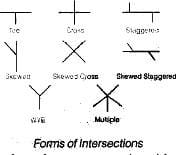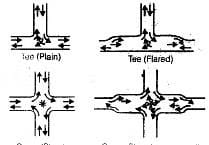Intersection: Traffic Engineering | Transportation Engineering - Civil Engineering (CE) PDF Download
Intersection
Intersections may be classified into two broad groups:
- Intersection at grade
- Grade separated intersection
1. Intersection at Grade:
- These include all roads which meet at more or less the same level.
- The traffic maneuvers like merging. diverging and crossing are involved in the intersection at grade.
- These intersections may be further classified as unchannelized, channelized and rotary intersections.
The basic requirements of intersection at grade are:
- At the intersection the area of conflict should be as small as possible.
- The relative speed and particularly the angle of approach of the vehicle should be small.
- Adequate approaching should be available for vehicles approaching the intersection.
- Sudden change of path should be avoided.
(a) Unchannelized intersections:
The intersection area is paved and there is absolutely no restriction to vehicles to use any part of the intersection area.
When no additional pavement width for turning movement is provided, it is called plain intersection.
When the pavement is widened at the intersection area, by a traffic lane or more, it is known as flared intersection. The conflict area is quite large as path of turning vehicles are not restricted or controlled. One of the crossing vehicles will have to stop while the other proceeds.
(b) Channelized intersections:
Channelized intersection is achieved introducing islands into the intersection area, thus reducing the total conflict area available in the unchannelized intersection.
(c) Rotary intersection:
It is an enlarged road intersection where all converging vehicles are forced to move round a large central island in one direction (clockwise direction) before they can weave out of traffic flow into their respective directions.
Design Factors of Rotary
- Design Speed 40 kmph for rotaries in rural areas 30 kmph for rotaries in urban areas
- Shape of Central Island


The shape of central island depends on the number and the layout of the intersecting roads.
When two equally important roads cross at roughly right angles i.e., all the four radiating roads placed symmetrically, a circular shape is suitable.
The island may be often elongated to accomodate in the layout four or more intersecting roads; and to allow for greater traffic flow along the direction of elongation.
Too much elongation and tangent shape are not desirable as there is a tendency of traffic in this direction to move much faster.
Turbine shape forces reduction in speeds of vehicle entering the rotary and enables speeding
R = V2/127f up of vehicles going out; however at night, the head light glare is a limitation of the design.
Radius of Rotary Roadway
Where, V = design speed of vehicle, kmph
f = coefficient of friction, may be taken as 0.43 and 0.47 for the speeds 40 and 30 kmph respectively, after allowing a factor of safety of 1.5.
The recommended minimum radii of central island are 1.33 times the radius of entry curves.
The IRC has suggested the radius of entry curve to be 20 to 35 m and 15 to 25 m for rotary design speeds of 40 and 30 kmph.
Wearing angle and weaving distance
The angle between the path of a vehicle entering the rotary and that of another vehicle leaving the rotary at adjacent road, thus crossing the path of the former is termed as the wearing angle.
The wearing operation including merging and diverging can take place between the two channelizing islands of the adjacent intersecting legs and this length of the rotatory roadway is known as weaving length.
For smooth flow of traffic the weaving angle should be small put not less than 15° as the diameter of central island required will be too large.
The weaving length should be at least four times the width of weaving section.
The recommended value of weaving length are 45 to 90 m for 40 kmph and 30 to 60 m for 30 kmph design speeds.
Width and Radius of Carriageway at entry and exit
The minimum width of carriageway at the entrance and exit should be 5.0 m.
Vehicles leaving the rotary would accelerate to the speed of the radiating roads and hence the exit curves should be of a larger radius than entry curves; one and a half to two times radius of entry is considered reasonable.
The pavement width at entrance curve will be higher than at exit curve as the radius of the former is less than the latter.
Other design standards
The shape and size of channelizing island is governed by the radius of the rotary the radii of the entrance and exit curves and the angles and layout of the radial road and rotary.
The design of the curve should be made assuming no super elevation.
The minimum sight distance should be 45 and 30 m for design speeds of 40 and 30 kmph respectively.
Condition When Traffic Rotary is Justified
The lowest limit of traffic volume when a traffic rotary is justified is about 500 vehicles per hour on all intersecting roads put together and the maximum limit beyond which rotary may not efficiency function is about 5000 vehicles per hour.
IRC suggests that the maximum volume of traffic that a rotary can efficiency handle is 3000 vehicles per hour entering from all the legs of the intersection.
Traffic rotary may be provided where the intersecting motor traffic is about 50 percent or more of the total traffic on all intersecting roads or where the fast traffic turning right is as least as 30 percent of the total traffic.
Advantages and Limitations of Traffic Rotary
- Crossing maneuver is converted into weaving or merging and diverging operations.
- The variable cost of operation of automobile is less at a traffic rotary than at a signalized intersection where the vehicles have to stop and proceed.
- The possible number of accidents and the severity of accidents are quite low because of low relative speed.
- Rotaries can be constructed with advantage when the number of intersecting roads is between four and seven.
- The capacity of the rotary intersection is the highest of all other intersections at grade.
Limitation
- Rotary requires comparatively a large area of land and so where space is limited and costly as in built up areas, the total cost may be very high.
- Where pedestrian traffic is large as in urban areas the rotary by itself cannot control the traffic and hence has to be supplemented by traffic police.
- Where the angle of intersection of two roads is too acute or when there are more than seven intersecting roads, rotatery are unsuitable.
Grade Separated Intersections
- The intersecting roads are separated by difference in level, thus eliminating the crossing maneuvers.
- The grade separation may be either by an overbridge or an under pass.
- Transfer of route at the grade separation is provided by interchange facilities consisting of ramps.
- Interchange ramps may be classified as direct, semidirect or indirect.
- The direct interchange ramp involve diverging to right side and merging from the right. Semidirect interchange ramp allow s diverging to left but merging is from right side.
- In the indirect method of interchange ramp, a simple diverging to the left and a merging from the left side are involved which are simpler and less hazardous than diverging to the right and merging from right; but the distance to be traversed in indirect interchange is more.

Advantages of Grade Separation
- Maximum facility is given to the crossing traffic.
- As the roads are separate, this avoids necessity of stopping and avoids accidents while crossing.
- There is increased safety for turning traffic and by indirect interchange ramp even right turn movement is made quite easy and safe by converting into diverging to left and merging from left.
- The capacity of the grade operated intersection can practically approach that of the two cross roads.
- It is possible to adopt grade separation for all likely angles and layout of intersecting roads.
Disadvantages
- It is very costly to provide complete grade separation and interchange facilities.
- Where there is a limited right of way like built up or urban area or where the topography is not favorable, construction of grade separation is costly, difficult and undesirable.
- In flat or plain terrain, grade separation may introduce undesirable crests and sags in the vertical alignment.
Grade Separation Structures
The grade separated intersections are classified as over-pass and under pass. When the major highway is taken above by raising its profile above the general ground level by embankment and an overbridge across another highway, it is called an over-pass. If the highway is taken by depressing it below the ground level to cross another road by means of an under-bridge, it is known as under-pass.
The choice of the over-pass or under-pass depends on topography, vertical alignment, drainage, economy, aesthetic features and preferential aspects for one of the highways.
Advantages of Over-pass
- Troublesome drainage problems may be reduced by taking the major highway above the cross road.
- For the same type of structure when the wider road is taken above the span of the bridge being
- small, the cost of the bridge structure will be less.
- In an overpass of major highway, there is an aesthetic preference to the main through traffic and less feeling of restriction or confinement when compared with the under-pass.
- Future expansion or lat eral expansion or construction of separate bridge structure for divided highway is possible.
Disadvantages of Over-pass
- In rolling terrain, if the major road is to be taken above, the vertical profile will also have a rolling grade line.
- If the major highway is to be taken over by constructing high embankments and by providing steep gradients, the increased grade resistance may cause speed reduction on heavy vehicles. Here will be restrictions to sight distance unless long vertical curves are provided.
Advantages of an Underpass
- The is a warning to traffic in advance due to the presence of an under pass which can be seen from distance.
- When the major highway is taken below, it is advantageous to the turning traffic because the traffic from the cross road can accelerate while descending the ramp to the major highway and the traffic from the major highway can decelerate while ascending the ramp to the cross roads.
- The under-pass may be of advantage when the main highway is taken along the existing grade without alteration of its vertical alignment and cross road is depressed and taken underneath.
Disadvantage of an Underpass
- There may be troublesome drainage problems at the under pass, especially when the ground water level rises high during rainy season.
- At under-pass the over head structure may restrict the vertical sight distance even at the valley curve near the under-pass.
- There is a feeling of restriction to the traffic at the sides while passing along the under-pass and unless the clearance is sufficiently large, this may affect the capacity at the intersection.
- There is no possibility of stage construction for the bridge structure at the under-pass.
Lighting Layouts
- Single side lighting is economical to install; but is suitable only for narrow roads. For wider roads with 3 or more laws the staggered system or the central lighting system may be adopted.
- Lights are installed at closer spacings on curves than on straights. The lights are located on the
- outer side of the curves to provide better visibility.
- At summit curve lights should be installed at closer intervals near the summit.
- For simple intersections, in urban area, the illumination should be at least equal to the sum of illumination values for two roads which form the intersection.
Spacing between lighting units
Average maintenance factor may be assumed = 0.8.
|
26 videos|91 docs|58 tests
|

|
Explore Courses for Civil Engineering (CE) exam
|

|


















